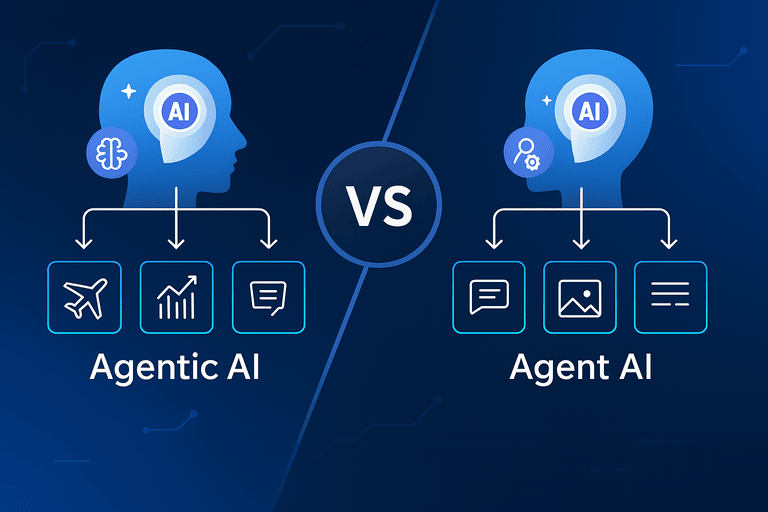Quick take 🏎️ – Agentique IA (agentic AI) is sprinting past classic Agent IA (script-based agents). By fusing large-language-model reasoning with a perception-reason-action loop, these systems move from automatisation to true autonomie—refining their own goals, launching multistep plans, and learning on the fly. That unlocks big wins in e-commerce, marketing, IT, and even compliance, but it also drags fresh ethical and regulatory questions into the spotlight.
Agent IA vs Agentique IA – How Autonomie Is Evolving Beyond Simple Automatisation
Transformation of Autonomie
Traditional Agent IA sticks to a script; change the context and it stalls. Agentique IA, by contrast, sets goals, decomposes tasks, and iterates until it wins—exactly the leap Rapid7 highlights in cybersecurity use-cases (Rapid7).
🔥 Pro tip: When you brief an agentic system, think “objective + guardrails,” not “step-by-step instructions.”
Why This Matters for Humans
McKinsey pegs the productivity upside of generative-and-agentic AI at $4.4 trillion annually (McKinsey & Company). That’s the kind of macro shift that turned spreadsheets into finance careers. Expect similar role-redefinition here.
“Agentic AI gets us closer to use cases we once filed under science fiction—complex workflows, minimal human intervention.” — IBM Think
Architecture Deep-Dive – The Perception ➜ Reasoning ➜ Action Loop
The Cyclic Engine
Agentique IA runs a tight loop: ingest context, reason, act, then reflect. AutoGPT’s open-source diagram shows memory, vector search and tool-calling stitched together in this cycle. The result? Continuous self-improvement.
Goal Reinvention on the Fly
These agents can rewrite their own sub-goals mid-mission—something classic agents never did. IBM notes that LLM-driven planners plus tool execution enable “workflow design” autonomy.
Hybrid Architectures
Research on neuro-symbolic hybrids confirms that pairing symbolic planning with LLM intuition boosts reliability.
Ethics, Governance & The EU AI Act – Who Owns Autonomous Decisions?
Europe’s AI Act was built for systems with fixed scope; a recent CEPS/BABL report warns that self-evolving agents blur provider liability and risk classes. Alignment, audit trails and “human-on-the-loop” oversight—IBM’s term—are now mandatory design layers.
⚠️ Quick tip: Sandbox tool-calls and log every decision to preserve forensic traceability, as Cognigy’s risk-mitigation playbook recommends.
Hybridisation & Convergence – Classic Agents Super-Charged by Agentique Modules
E-commerce chatbots that once followed intents now call an agentic pricing micro-service; RPA bots trigger LLM planners for edge cases. This “best-of-both” is precisely what SmythOS and other frameworks describe as a reactive-plus-deliberative stack.
Real-World Wins – How Agentique IA Runs a Shopify Store End-to-End
Product Catalogue & Content
Shopify’s 2025 guide shows agents generating descriptions, images and even short videos directly from inventory data. Pair that with an LLM vision model and your catalogue updates itself.
🔥 Tip: Index your DAM (Digital Asset Manager) so the agent always finds brand-approved visuals.
Customer Support & Revenue Recovery
Agents field chats, emails and voice calls 24/7, escalate only anomalies, and have already lifted conversion rates for early adopters.
Autonomous Growth Loops
From abandoned-cart nudges to dynamic bundling, agents watch behavioural data and tweak offers without waiting for a marketer’s A/B test.
Marketing Automation – From Google Ads to Cross-Channel Funnels
Google’s new Marketing Advisor agent slots straight into Chrome to optimise bids, creatives and landing pages in real time. Expect similar agentic layers for Amazon Ads, Meta Advantage+ and TikTok Spark soon.
“With agentic capabilities, marketers steer strategy while the AI pilots execution—goodbye micro-management.”
New Jobs & Skills – Designing, Supervising & Auditing Autonomie
Devin, the autonomous software engineer, crushed previous coding-agent benchmarks by 7×. That hints at new meta-roles:
- Prompt Architect – scopes objectives & guardrails.
- Control-Logic Auditor – stress-tests agent loops for alignment flaws.
- AI Policy Lead – maps deployments to evolving regulations (see BABL report).
Getting Started – Action Checklist
- Map repetitive workflows where outcome > process detail.
- Define KPIs & constraints up front; agents optimise what you measure.
- Pilot in a sandbox with tight observability; iterate on failure modes.
- Upskill your team—McKinsey finds employees are 3× more ready for AI than leaders expect.
- Scale progressively, layering compliance gates aligned to AI Act risk tiers.
🤔 Over to You
Which task would you hand over to an agentic assistant first? Drop your answer in the comments, or share this guide with a teammate who still thinks “automation” means a simple macro.
Stay curious, stay in the loop, and let’s build the future of productive autonomy together! 💬
